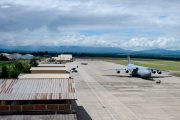Defense Minister Juan Carlos Pinzón said FARC (Revolutionary Armed Forces of Colombia — People’s Army) leader Alfonso Cano was killed in a raid on a town in the Cauca department of Colombia, having been chased months ago out of a FARC stronghold in the mountains in the southwest area of the country.
Pinzón declared that Cano had been pursued relentlessly by armed forces in the southwestern Colombian state and was killed just hours after several of his lieutenants were killed in a bombing raid in Suarez, a rural town in Cauca.
The Colombian army may have been aided in its efforts to locate Cano (real name: Guillermo Saenz) by locals motivated to cooperate with the government by the offer of a reward of $3.7 million for information that led to his capture.
Cano, for decades the ideological polestar of the leftist movement, was known to be an intellectual and a hardliner with his eyes firmly fixed on a final triumph over the forces of the government of Colombia. He took command of FARC in March 2008 upon the death of Manuel Marulanda Velez (A.K.A. “Tiro Fijo”).
Arrested in 1981, Cano served an 18-month prison sentence before being released by then-President Belisario Betancur. Upon his release, Cano declined an offer from Moscow to live out his life in Russian exile.
Absolutely committed to the communist cause, Cano founded in 2000 the Clandestine Colombian Communist Party, remaining its leader until his death.
The U.S. State Department said it holds him responsible for drug trafficking into the United States, and in March 2006, he and 49 other FARC leaders were indicted on charges of importing and distributing cocaine. At that time, a $5-million bounty was placed by the State Department on the head of Alfonso Cano.
Cano, 63, proved elusive, however, and was known to travel back and forth between his hideout and Bogota, often in disguise. Despite his efforts to cover his tracks, Cano reportedly was finally tracked down in the jungle by a triangulation method using telephone intercepts as markers of his location.
While some still doubt the veracity of the death, reports out of Colombia indicate that the body of the former guerrilla leader has been shown on television.
Additionally, there have reportedly been other tests conducted on the body.
"The fingerprints matched," one senior security official was quoted as saying by the Associated Press. The identification test was supposed to have occurred before the body was transferred to the Cauca capital city of Popayán.
After word of the raid’s successful elimination of its target, Cauca State Governor Gonzalez Mosquera commented to a local radio station that the Colombian military had now "achieved one of its most important goals."
FARC promotes itself as a “peasant army,” with an agrarian, Leninist philosophy. Such principles do not lend themselves easily to fundraising, but FARC has prospered for years as a result of ransoms from kidnapping and profits derived from a successful elicit drug trade, including the manufacture of cocaine.
As is natural with guerrilla armies, it is difficult to accurately estimate the size of FARC’s army. According to Colombian Armed Forces Commander Admiral Édgar Cely, FARC had a total of 18,000 members in 2010, with about 9,000 of those being armed soldiers, while the rest of the group’s membership performed support and undercover intelligence gathering roles. Some observers report that the size of FARC’s actual combat-ready force is numbered between 9,000 to 11,200 men.
According to a report of Cano’s death in the New York Times, “A drive backed by the United States has in recent years thinned the ranks to around 8,000, according to Reuters. The members were driven into remote hideaways.”
The Colombian government’s crackdown on FARC has been somewhat successful in recent years, particularly regarding the leaders of the group.
Cano assumed command of the terrorist organization after the co-founder, Manuel Marulanda, died of a heart attack on March 26, 2008.
Then, in September 2010, Colombian authorities announced the death of Mono Jojoy. According to President Juan Manuel Santos, the FARC field commander was killed in the Colombian state of Meta in an air raid similar to the one that claimed the life of Cano.
The tracking and killing of FARC leadership by the Colombian government was substantially subsidized by the United States taxpayer, as billions of dollars of funding, intelligence resources, and military training were given to Colombia over the past few years.
America’s financing of Colombia’s “War on Drugs,” known as Plan Colombia, was described by Paul Wolfowitz as a “novel model” that the United States could follow in Afghanistan. Supporters of the plan consider it an international extension of the American “War on Drugs” begun in 1971 by Richard Nixon. NPR recently reviewed the history of the foreign aid package.
In 1998 and 1999, Andrés Pastrana, Colombia's newly elected president, hatched a strategy to tackle a bloody left-wing, anti-government insurgency that had plagued the country for decades. Pastrana would attack the roots of the problem: the lucrative cocaine and heroin trade funding the Revolutionary Armed Forces of Colombia (FARC) and National Liberation Army (ELN), and the lack of social and institutional development in the country. He called it a "Marshall Plan" for Colombia and appealed to the international community to help foot the bill for what he initially envisioned as a six-year, $7.5 billion program.
The impact of the death of Alfonso Cano will be difficult to ascertain, especially in light of the guerrilla nature of FARC. According to a story published in the Associated Press, the death of Cano removes the ideological head from a group with dwindling membership, likely to lack a clear successor.
A story in Reuters supposed that the killing will not bring an end to the nearly five decades of terror perpetrated by FARC and its fellows.
As for how the killing of Cano will impact the flow of cash from Washington, that remains to be seen.
Photo of Alfonso Cano: AP Images



